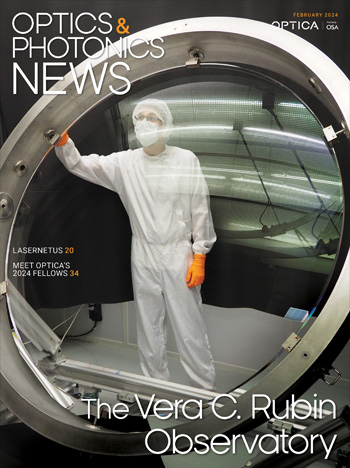
July 1999 Issue
- Etienne Louis Malus
- How to Make Holograms Using a Laser Pointer
- Painting Cameras: The Newest Art Form in Photography
- The Role of Lasers in Fine Arts Conservation and Restoration
- MATLAB for Beginners
- Diffraction Gratings, Part 1
- Fast IR Fisheye Lens with Hyper-Hemispherical Field of View
- Browse all Issues
Feature Articles
Etienne Louis Malus
Throughout his life, Malus had a considerable impact on optics. Amazingly, his accomplishments were made in spite of many hardships and interruptions during his life. He overcame political intrigue, war, and the plague. A review of his life shows that Malus was no accidental contributor to optics. He conducted experiments that verified Huygens' theory of birefringence and was able to express the theory analytically. His work at that time was so highly received that in 1811 he was awarded the Rumford medal of the Royal Society (London), established in the early 1800s by the American-born Benjamin Thompson, Count Rumford. This award was presented to Malus even though France and England were in a war that led to the involvement of the United States in 1812.
by Bob GuentherHow to Make Holograms Using a Laser Pointer
The construction and use of simple holograms, and their use in performing experiments, is an excellent way to introduce students to the study of optics.
by Tung H. Jeong, Raymond J. Ro, Masashi IwasakiPainting Cameras: The Newest Art Form in Photography
Optical adaptations of camera lenses and techniques have changed and will continue to change the opportunities for photographic artists to manipulate images more creatively.
by Jannick P. Rolland and Steve L. HylenThe Role of Lasers in Fine Arts Conservation and Restoration
Ancient artwork and modern science: working together to save our cultural heritage using lasers in art conservation and restoration.
by Adele de Cruz, Susanne A. Hauger, and Myron L. WolbarshtMATLAB for Beginners
The MATLAB 5 Handbook, by Darren Redfern and Colin Campbell, is an introduction to the MATLAB (matrix laboratory) programming language for beginners, as well as a reference book for experienced users.1 It is, according to the authors, "written for all MATLAB users, regardless of their discipline or field(s) of interest." MATLAB is an interpretive (not compiled) programming language based on arrays and matrices, and has many powerful, built-in, mathematical, and graphing functions.
by Christopher R. DoerrDiffraction Gratings, Part 1
The goal of the present article is to describe some of the basic properties of gratings, and to point out through several examples the complex behavior of these devices. These examples are by no means comprehensive, but they should make it amply clear that there is no simple way to predict a grating's diffraction efficiency.
by Masud Mansuripur, Lifeng Li, Wei-Hung YehFast IR Fisheye Lens with Hyper-Hemispherical Field of View
This month's patent design is a fisheye lens for long wavelength IR (8-12 μm wavelength range) that covers a full field of 270° at an astonishingly large aperture of f/0.7. This combination of field coverage and aperture is unprecedented, but in spite of the extreme specifications, the design is quite simple, consisting of only four germanium elements. The design would provide an interesting challenge to a manufacturer because the concave surface of the negative meniscus front element is hyper-hemispherical
by J. Brian Caldwell
![A multiplexed image of a human tonsil acquired. [NIAID] using the iterative bleaching extends multiplexity (IBEX) method.](https://opnmedia.blob.core.windows.net/$web/opn/media/images/articles/2024/0424/departments/202404-cover-web.jpg?ext=.jpg)

